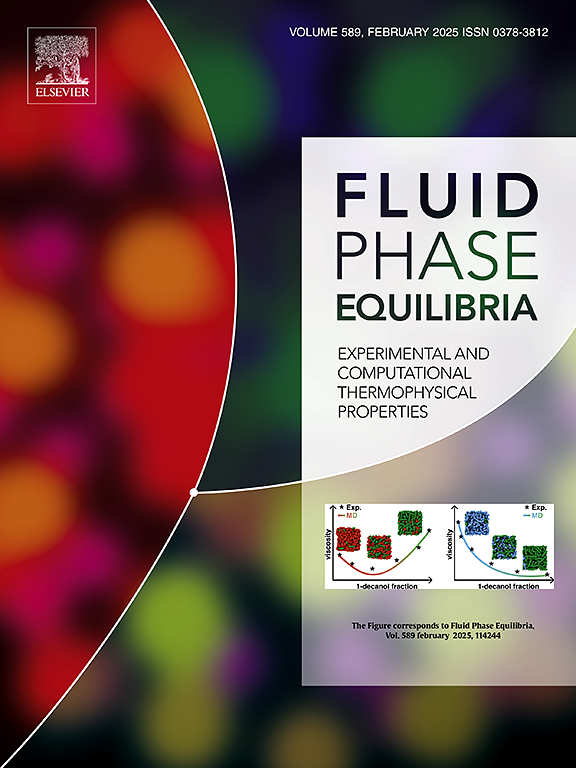基于预测热力学模型的抗溶剂选择方法
IF 2.7
3区 工程技术
Q3 CHEMISTRY, PHYSICAL
引用次数: 0
摘要
淹没结晶是一种有效的从溶液中分离溶质的技术,通过引入一种称为反溶剂的质量分离剂。虽然以前使用cosmos - sac (SLE)的研究仅限于二元溶质-溶剂平衡,但本研究引入了第一个选择抗溶剂的集成方案。该方案将cosmos - sac (SLE)与无限稀释选择性描述符和沉淀质量平衡相结合,以分析全三元体系(溶质,溶剂和反溶剂)。在298.15 K的温度下,用9种不同的反溶剂在1-丁醇或DMF中获得了琥珀酸、戊二酸和己二酸的固液平衡(SLE)数据。四种预测模型cosmos - sac (SLE)、cosmos - sac(2017)、nist修改的UNIFAC和原始UNIFAC根据这些数据进行基准测试。COSMO-SAC (SLE)模型在降水质量方面的中位相对偏差为58%,比次优模型提高了三倍,标志着COSMO-SAC (SLE)预测降水产量的首次定量验证。高选择性值准确地预测完全淹没或液-液相分离,而低选择性值表示完全溶解。对σ-剖面的分析揭示了极性和非极性表面重叠程度与观察到的相行为之间的联系,提供了超越简单的经验基准的机制理解。由此产生的工作流程——包括模型筛选、选择性排序、σ-剖面解释和实验验证——为制药和精细化学结晶中溶剂和反溶剂的选择提供了可靠的方法。本文章由计算机程序翻译,如有差异,请以英文原文为准。
Antisolvent selection method based on predictive thermodynamic models
Drowning-out crystallization is an effective technique for separating solutes from solutions by introducing a mass separation agent called an antisolvent. While previous studies using COSMO-SAC (SLE) were limited to binary solute–solvent equilibria, this research introduces the first integrated protocol for selecting an antisolvent. This protocol combines COSMO-SAC (SLE) with an infinite-dilution selectivity descriptor and a precipitation mass balance to analyze full ternary systems (solute, solvent, and antisolvent). New solid-liquid equilibrium (SLE) data were collected for succinic, glutaric, and adipic acids in 1-butanol or DMF with nine different antisolvents at a temperature of 298.15 K. Four predictive models—COSMO-SAC (SLE), COSMO-SAC (2017), NIST-modified UNIFAC, and original UNIFAC—were benchmarked against these data. The COSMO-SAC (SLE) model achieved a median relative deviation in precipitated mass of 58%, representing a threefold improvement over the next best model, marking the first quantitative validation of COSMO-SAC (SLE) for predicting precipitation yields. High selectivity values accurately forecast complete drowning-out or liquid-liquid phase separation, while low values indicate full solubility. Analysis of the σ-profile reveals a connection between the extent of polar and non-polar surface overlap and the observed phase behavior, providing a mechanistic understanding beyond simple empirical benchmarking. The resulting workflow—comprising model screening, selectivity ranking, σ-profile interpretation, and experimental validation—offers a reliable approach for selecting solvents and antisolvents in pharmaceutical and fine chemical crystallization.
求助全文
通过发布文献求助,成功后即可免费获取论文全文。
去求助
来源期刊

Fluid Phase Equilibria
工程技术-工程:化工
CiteScore
5.30
自引率
15.40%
发文量
223
审稿时长
53 days
期刊介绍:
Fluid Phase Equilibria publishes high-quality papers dealing with experimental, theoretical, and applied research related to equilibrium and transport properties of fluids, solids, and interfaces. Subjects of interest include physical/phase and chemical equilibria; equilibrium and nonequilibrium thermophysical properties; fundamental thermodynamic relations; and stability. The systems central to the journal include pure substances and mixtures of organic and inorganic materials, including polymers, biochemicals, and surfactants with sufficient characterization of composition and purity for the results to be reproduced. Alloys are of interest only when thermodynamic studies are included, purely material studies will not be considered. In all cases, authors are expected to provide physical or chemical interpretations of the results.
Experimental research can include measurements under all conditions of temperature, pressure, and composition, including critical and supercritical. Measurements are to be associated with systems and conditions of fundamental or applied interest, and may not be only a collection of routine data, such as physical property or solubility measurements at limited pressures and temperatures close to ambient, or surfactant studies focussed strictly on micellisation or micelle structure. Papers reporting common data must be accompanied by new physical insights and/or contemporary or new theory or techniques.
 求助内容:
求助内容: 应助结果提醒方式:
应助结果提醒方式:


